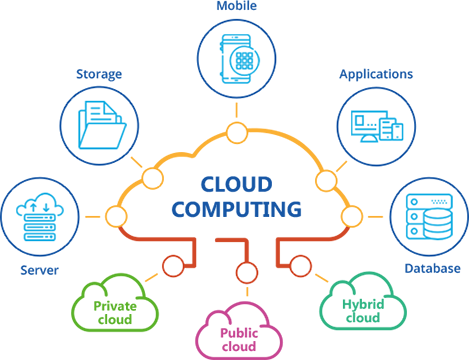Discover LinkDaddy Cloud Services for Universal Cloud Service Success: Press Release Insights
Wiki Article
Simplify Your Infrastructure With Cloud Services
As companies navigate the ever-evolving landscape of technology and information management, the duty of cloud solutions in simplifying facilities has come to be increasingly famous. Exactly how can services successfully navigate this shift and genuinely open the possibility of cloud services for simplifying their framework?Benefits of Cloud Provider
Cloud solutions provide a structured method to handling IT infrastructure, offering businesses with flexibility, scalability, and cost-efficiency. One of the vital benefits of cloud services is the scalability they offer. Companies can conveniently scale their resources up or down based upon need, guaranteeing they only spend for what they use. This versatility is specifically useful for companies with changing needs or those experiencing development.Additionally, cloud solutions remove the need for businesses to purchase costly equipment and software. This cost-efficiency is a considerable advantage, especially for small to medium-sized business aiming to minimize in advance prices. By using cloud solutions, organizations can access premium IT sources without the large cost tag related to conventional facilities configurations.
Additionally, cloud solutions offer companies with the versatility to access their information and applications from anywhere with a web link. This degree of accessibility improves partnership amongst teams, enables remote job, and increases total efficiency. The adaptability provided by cloud services encourages companies to adjust promptly to changing market problems and customer needs.
Cost Financial Savings and Scalability
In enhancement to the functional benefits highlighted earlier, the integration of cloud services into a company's facilities yields significant cost savings and enhanced scalability. Cloud services provide a pay-as-you-go version, permitting companies to range sources up or down based on present needs, thus avoiding the expenses related to maintaining excess ability. This adaptability makes it possible for companies to adjust quickly to changing demands without incurring unneeded expenses.Moreover, cloud solutions get rid of the need for ahead of time financial investments in software and hardware, reducing capital investment. Operating budget are likewise reduced as business no more need to manage and keep physical web servers, bring about lower power usage and IT staffing prices. Additionally, cloud solutions provide automated updates and upkeep, ensuring that the facilities remains protected and current without needing hand-operated interventions.
Enhanced Protection Measures
Executing strict security actions is paramount when integrating cloud services right into a company's framework to guard delicate data and ensure compliance with sector regulations. Cloud company supply boosted protection attributes such as data encryption, firewall software defense, and multi-factor authentication to minimize cybersecurity threats. Security helps protect information both at remainder and en route, ensuring that just licensed individuals can access delicate details. Firewall softwares function as an obstacle between inner networks and exterior risks, surveillance and controlling incoming and outgoing network traffic. Multi-factor verification includes an extra layer of safety by needing customers to supply multiple forms of confirmation before accessing the cloud solutions.In addition, normal safety audits and compliance analyses assist make sure and recognize vulnerabilities adherence to industry criteria. Companies can additionally take advantage of attributes like automatic safety and security updates and real-time threat surveillance provided by cloud solution providers. By prioritizing protection steps and remaining aggressive in attending to possible risks, companies can with confidence utilize cloud services while shielding their valuable data from unauthorized accessibility or violations.
Transitioning to Cloud Infrastructure
To effectively integrate cloud services right into a company's framework, a structured strategy that attends to the change in the direction of cloud-based solutions is imperative. Transitioning to cloud framework involves mindful planning and implementation to make certain a smooth movement procedure - Cloud Services.When the evaluation is full, a migration strategy should be established. This strategy needs to describe the timeline, resources, and obligations for relocating each component to the cloud. It is important to interact this strategy plainly to all stakeholders to ensure placement and decrease disruptions during the change.
During the movement procedure, monitoring and testing are vital to identify and deal with any kind of concerns immediately. Regular checkpoints must be established to track progress and make required changes. In addition, training for staff members on using cloud solutions must be offered to guarantee a successful change and make best use of the benefits of the new facilities.
Ideal Practices for Cloud Fostering
Effective adoption of cloud services rests on the calculated alignment of company goals with technological abilities and organizational readiness. To ensure a smooth shift to the cloud, organizations must begin by performing a thorough evaluation of their find more present framework and identifying which workloads are best suited for cloud movement. It is important to entail crucial stakeholders from different departments in the decision-making procedure to obtain buy-in and resolve any kind of concerns early on.One more best practice for cloud fostering is to focus on security and conformity. Organizations must very carefully review the security steps supplied by cloud service carriers and ensure that their information is shielded according to market standards and governing requirements. Carrying out durable information file encryption, accessibility controls, and regular protection audits can aid reduce dangers related to cloud read the article fostering.

Final Thought

As organizations navigate the ever-evolving landscape of modern technology and data administration, the role of cloud services in simplifying facilities has actually become increasingly popular - cloud services press release. How can services properly navigate this shift and really open the possibility of cloud solutions for simplifying their framework?
Cloud services provide a structured method to handling IT infrastructure, giving organizations with adaptability, cost-efficiency, and scalability. By utilizing cloud solutions, businesses can access premium IT sources without the hefty price tag associated with conventional infrastructure configurations.
To make certain a smooth change to the cloud, companies must start by carrying out a comprehensive evaluation of their existing facilities and recognizing which work are best suited for cloud movement.
Report this wiki page